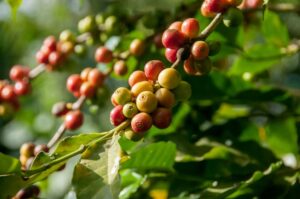Physical Address
23,24,25 & 26, 2nd Floor, Software Technology Park India, Opp: Garware Stadium,MIDC, Chikalthana, Aurangabad, Maharashtra – 431001 India
Physical Address
23,24,25 & 26, 2nd Floor, Software Technology Park India, Opp: Garware Stadium,MIDC, Chikalthana, Aurangabad, Maharashtra – 431001 India

Climate change is reshaping agriculture worldwide, and Sri Lanka’s specialty coffee sector is no exception. The cultivation of Coffee Arabica, renowned for its superior flavour profile and demanding environmental requirements, is particularly vulnerable to erratic weather patterns. Rising global temperatures, unpredictable rainfall, and shifting growing seasons are posing major challenges to coffee farmers, threatening the delicate balance required for producing premium-quality beans. These changes highlight the urgent need for innovation and climate-resilient practices to ensure the sustainability of the island nation’s coffee industry. As Sri Lanka tackles these challenges, it also finds opportunities to redefine its role in the global specialty coffee market, embracing resilience and adaptability as its guiding principles.
Sri Lanka’s Specialty Coffee Potential
Sri Lanka’s coffee production primarily focuses on Coffea arabica L. (Arabica), which is more in demand globally due to its superior flavor profile, smooth texture, and aromatic complexity. Coffea arabica L. (Arabica) thrives in cooler, high-altitude environments, typically at elevations of 1,000–2,200 meters above sea level. It requires average annual temperatures of 18–24°C and consistent rainfall between 1,500–2,750 mm per year. The fertile, well-drained soils in Sri Lanka’s central highlands, such as in Nuwara Eliya and Kandy, provide ideal conditions for producing premium-quality beans.
Coffea canephora Pierre ex A.Froehner (commonly known as Robusta), on the other hand, is more resilient and can withstand higher temperatures and lower altitudes. It grows well at elevations below 800 meters, with average annual temperatures of 24–30°C and moderate to high rainfall, 1750mm higher. Robusta is commonly cultivated in the warmer, lower regions of Sri Lanka, such as in Matale and Gampaha, where its hardiness makes it better suited to challenging environmental conditions, albeit with a less complex flavor profile.
impact of climate change
Sri Lanka’s coffee cultivation, particularly Coffea arabica L. (Arabica), has historically depended on predictable weather patterns to thrive. Yet, as climate change disrupts these norms, the rhythm of coffee farming is being transformed, presenting both challenges and opportunities for the nation’s emerging specialty coffee market.
Dr. Lakshman Kumara Gamage, Deputy Director of Research at the Central Research Station of Department of Export Agriculture in Matale, highlights the intricate relationship between climate and coffee. He explains, “For optimal flowering, coffee plants like Coffea arabica require specific thermal conditions—most importantly, a spell of rain following a dry period of two to four weeks. Traditionally, Sri Lanka experienced two main flowering seasons for Coffea arabica: the major season from March to April and the minor one from October to December.”
But the once-predictable flowering cycles are now shifting. “In 2023, the flowering periods became irregular and spread across the year. We observed three distinct flowering periods: February to March, April to May, and October to December,” Dr. Gamage notes. This irregularity, coupled with erratic rainfall patterns, has disrupted soil moisture levels—vital for coffee plant health. Dr. Gamage further highlights that these climatic shifts not only impact flowering but also reduce yield and complicate post-harvest processes. Consequently, yields from the primary flowering season have declined, a worrying trend likely to extend into 2024.
Meanwhile, the cultivation of Coffea canephora Pierre ex A.Froehner, which thrives in warmer and more humid conditions, may offer some relief. However, its quality and market demand differ from that of the premium Arabica variety.
Despite these hurdles, hope remains. “We are conducting research and development, even with limited resources, to create climate-resilient coffee varieties,” Dr. Gamage shares, emphasizing that farmers who adhere closely to guidance from the Department of Export Agriculture can mitigate production losses.
Navigating an Uncertain Future
As global temperatures rise, Sri Lanka’s coffee-producing regions face increasing threats from pests and diseases such as coffee leaf rust (CLR) and coffee berry borer (CBB). These threats, combined with irregular rainfall patterns, have reduced the land area suitable for growing high-quality Arabica coffee.
To counteract these challenges, Sri Lanka’s coffee industry must adapt to the changing climate. Investments in research and development, diversification of coffee varieties, and innovative agricultural practices are essential. Techniques such as soil conservation, water management, and pest control are already being explored to enhance resilience.
Dr. Gamage’s vision for a sustainable coffee future extends to fostering collaboration between farmers, businesses, and the government. By integrating climate-resilient practices into Arabica production and expanding cultivation into newly suitable areas, Sri Lanka can maintain its competitive edge in the specialty coffee market.
Conclusion: Resilience Through Innovation
The story of Sri Lanka’s coffee industry is one of resilience and adaptability. Dr. Gamage’s insights underscore the importance of leveraging research, innovation, and cooperation to navigate the challenges posed by climate change. With the right investments and strategies, Sri Lanka has the potential to turn adversity into opportunity, solidifying its place as a key player in the global specialty coffee market.
References
https://marketdevelopmentfacility.org/wp-content/uploads/2024/06/SL-CC-Coffee_All-Web.pdf
https://www.srilankabusiness.com/food-and-beverages/coffee-from-sri-lanka.html
Banner Image: Photo by Rodrigo Flores on Unsplash